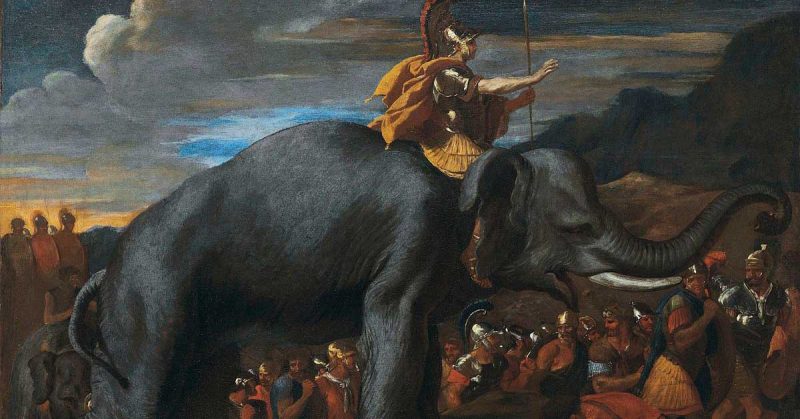The gut reaction for most people would be Alexander, but there are a few aspects which work for Hannibal considering the various terrain and weather situations in which a battle could be fought.
Alexander the Great was one of the greatest military minds in all history. Hannibal though had a way of evening the field by bringing his best units into the fight at the most appropriate time.
What ifs and history hypotheticals are not always appreciated by die-hard historians. “Hannibal and Alexander lived in different generations they would never have fought, so this is a stupid question.” Well to that I say hypotheticals are a great exercise in getting a better understanding of historical topics.
Historians seem to get shunned too often for having fun with history. That is unfortunate because cases like this are downright fascinating to think about, especially when getting a few different viewpoints on the matter. So after that tirade, here are some thoughts about how the battle might go down.
The two men and their armies were just about 100 years apart, pretty close in the ancient world regarding the evolution of tactics and technology.
In this particular scenario, we are taking Hannibal’s army a few years after Cannae. Here, his veterans have tremendous amounts of experience and have scavenged the best weapons and armor. We will also give Hannibal about 35 elephants, though he had lost these by this point in his campaign.
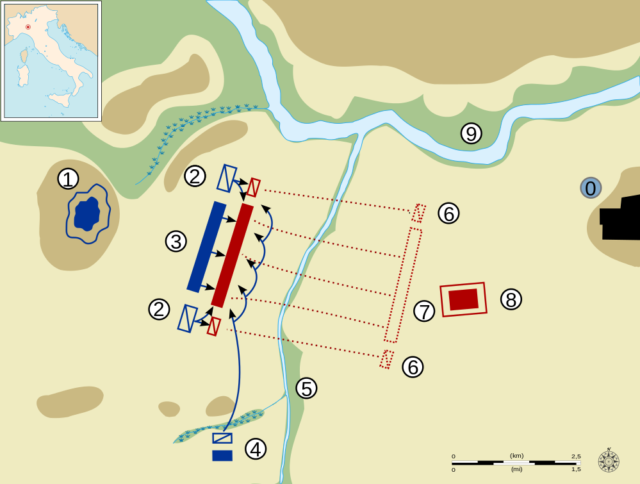
Hannibal’s army was a perfectly constructed jigsaw puzzle of many different nationalities of units. Gallic heavy infantry fought with well-forged armor and heavy swords and were famed for their bravery.
Spanish swordsmen fought in lighter armor but were so amazingly athletic and acrobatic with their high-quality falcata that they quite often held their own against the heaviest of infantry.
African infantry from Carthaginian homelands fought in a phalanx style. Their spears may have split the difference in length between Greek hoplite spears and the Macedonian Sarissa. They also scavenged the sturdy short swords from masses of vanquished legionaries.
Hannibal had hardy Spanish cavalry. These men rode strong horses and had some armor to stand with traditional Greek cavalry. The other branch of cavalry were the Numidians. These were light to the point that the only armor was a hide shield. They rode bareback with just a rope around the horse’s neck for guidance. Javelins were used at range and in melee. They relied on mobility to stay in the fight longer than most cavalry of the era could stand.
The majority of the army were not professionals but paid mercenaries, accustomed to fighting and never shying away from a battle.
The Macedonians were thoroughly professional. The men were extensively trained. This army was a bit simpler than Hannibal’s; the core was the phalanx with impressively long spears that made the enemy wade through three waves of spear points before closing with them.
On the vulnerable right/unshielded flank, there were shield bearer infantry known as Hypaspists. These were the elite of the Macedonian army, selected for the toughest jobs during Alexander’s campaign.
The cavalry were the great companions. The Macedonians had some light cavalry, but employed masses of heavy companion cavalry as the decisive arm of a battle using them as the “hammer” to the phalanx “anvil.”
Alexander was a tactical genius. He often relied on tactics played out in the face of the enemy as the battle progressed. Hannibal too did this but also relied heavily on pre-battle positioning and maneuvers.
Alexander went into a fight fairly confident of victory, notably refusing a night attack before Gaugamela. Hannibal sought to win the battle before the men even began fighting. We see this in the battles of Trebia and Trasimene.
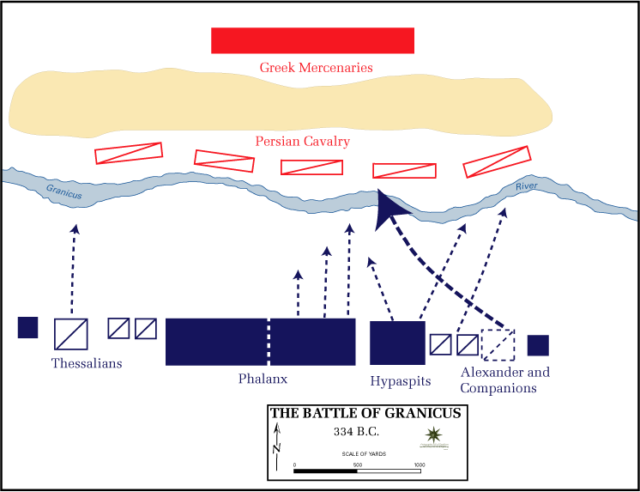
This battle we have taking place at a river crossing, say the Volturnus (present day Volturno) in southern Italy. Given the commander’s disposition, we can probably assume Alexander would have taken the offensive and forded his army across the river, though certainly not so simply as the Romans did at Trebia.
Alexander used a staggered crossing to concentrate his forces where he wanted at the battle of the Granicus, and it is likely he would do the same here. Hannibal would certainly have found a way to get the element of surprise. He may have been able to achieve this by sending his Numidian cavalry across the river in secret and having them strike Alexander’s troops after most of them had crossed.
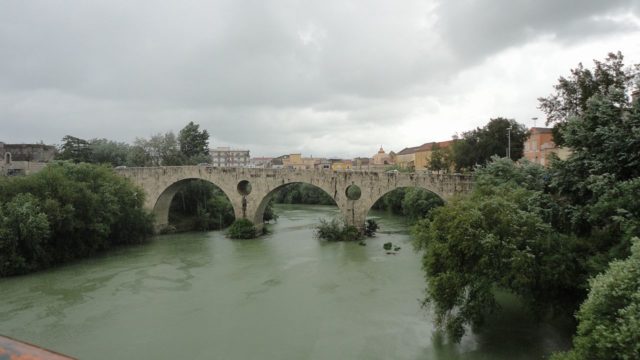
This would not have guaranteed a Carthaginian victory as Alexander’s disciplined phalanx was one of the only instances of such a formation able to go over rivers and rough terrain still in good formation. They would be facing the Carthaginians who would have Gauls in the center, Spanish infantry on either side and the African infantry on the flanks.
By this point, Alexander would have put on the pressure in at least one area through the positioning of his phalanx groups. The most likely area of penetration would be the Spanish infantry. They could fight with the most impressive display of swordsmanship, but ultimately the Macedonian Sarissa would wreak havoc on the unarmored Spaniards.
Alexander, likely on the right flank with his elite shield-bearers, would use misdirection. Swinging to his left to support his phalanx in overpowering the Spaniards and working into the enemy center, trusting his elite shield-bearers to hold the flank. Alexander’s strategy would be to isolate Hannibal’s center. Very slowly advancing his center while pushing through the Spaniards on either side to flank the Gallic center.
At this point, Hannibal’s Spanish cavalry and elephants would charge into the fray, the elephants smashing into the flanks along the riverbanks and reinforcing the wavering Spanish infantry.
The Spanish cavalry would attack Alexander’s forces, clashing with the companion cavalry at the seam between the Gauls and the left Spanish infantry.
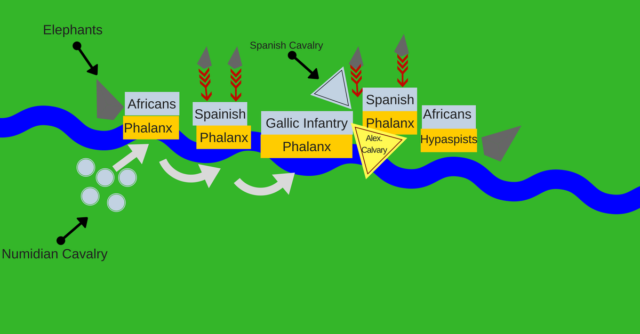
Here the battle could go either way.
If Alexander were to win, his forces would have to rout the Spanish infantry completely. This would leave the Gallic center exposed and they would likely run too. The elephants left alone would be ganged up on by the phalanx. Pushing forward enough would make the surprise attack by the Numidian cavalry irrelevant and victory would soon follow as Hannibal’s army would be split in two.
If Hannibal’s army were to win it would start with the panic induced by the Numidian surprise attack. Though the Spanish infantry would be hard pressed, forward progress could be stalled enough by the Numidian assault. Also, the perfectly timed counterattack suggests that Hannibal expected his Spanish infantry to fall a bit to the sustained phalanx push and probably even told his men to expect help from the elephants. This support would likely embolden the Spanish and trap the Macedonians against the riverbank.
Either way, the battle would have to be a tightly contested affair with very similar army sizes and fairly strong morale of the troops on both sides.
Of course, this is entirely speculation, but the tactics used echo the greatest tactics of both commanders.
Alexander loved to be aggressive and bring his finest troops to the best place they could be to break the enemy. His shield-bearers were certainly capable of holding the right flank even against the African infantry and the elephant charge. The left flank would be hard pressed against the elephants, but if Alexander were to succeed it would be over before the left threatened to fold.
Hannibal meanwhile, shows his ability to know his own troops’ weaknesses and predict what his enemy will do and the best way to counter it. Holding elephants back, then having them charge through the Spanish infantry is very unorthodox, but something Hannibal would figure out how to do. Possibly the Spaniards would open channels in their lines for the elephants to charge through, they were as light as skirmishing infantry, so would have the mobility to do so.
This is all one man’s opinion. What do you think?
